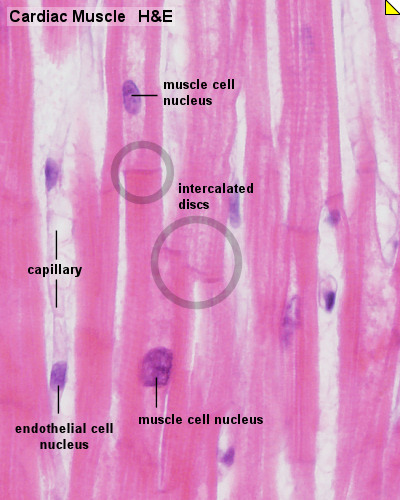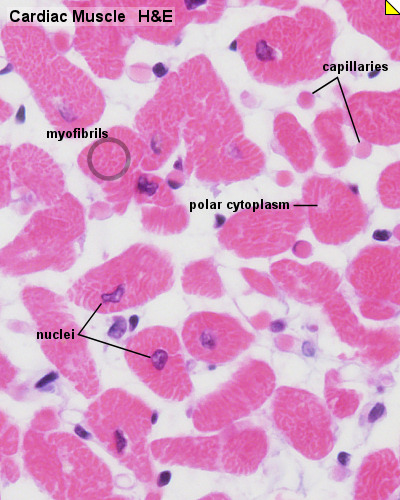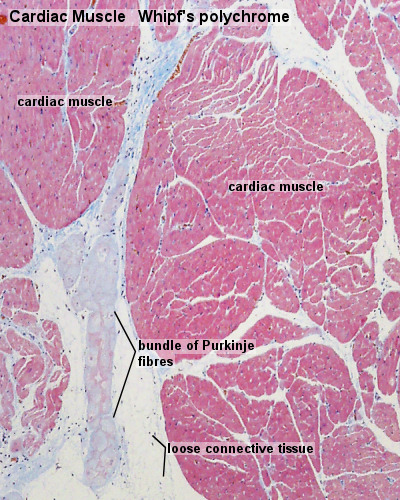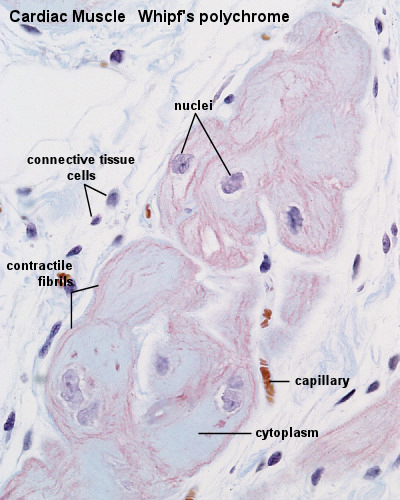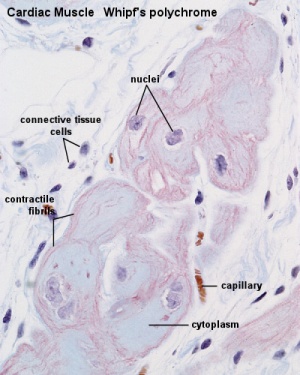Cardiovascular System - Heart Histology
| Embryology - 28 Apr 2024 |
|---|
| Google Translate - select your language from the list shown below (this will open a new external page) |
|
العربية | català | 中文 | 中國傳統的 | français | Deutsche | עִברִית | हिंदी | bahasa Indonesia | italiano | 日本語 | 한국어 | မြန်မာ | Pilipino | Polskie | português | ਪੰਜਾਬੀ ਦੇ | Română | русский | Español | Swahili | Svensk | ไทย | Türkçe | اردو | ייִדיש | Tiếng Việt These external translations are automated and may not be accurate. (More? About Translations) |
Introduction
The heart is composed of cardiac muscle, specialised conductive tissue, valves, blood vessels and connective tissue.
Cardiac muscle, the myocardium, consists of cross-striated muscle cells, cardiomyocytes, with one centrally placed nucleus.
- Nuclei are oval, rather pale and located centrally in the muscle cell which is 10 - 15 µm wide.
- Cardiac muscle cells excitation is mediated by rythmically active modified cardiac muscle cells.
- Cardiac muscle is innervated by the autonomic nervous system (involuntary), which adjusts the force generated by the muscle cells and the frequency of the heart beat.
- Cardiac muscle cells often branch at acute angles and are connected to each other by specialisations of the cell membrane in the region of the intercalated discs.
- Intercalated discs invariably occur at the ends of cardiac muscle cells in a region corresponding to the Z-line of the myofibrils.
- Cardiac muscle does not contain cells equivalent to the satellite cells of skeletal muscle.
For development information see Cardiac Embryology. I have redirected Cardiac Muscle Histology to this current page.
| Histology Links: stains | fixatives | artifacts | menstrual histology | placenta histology | heart histology | liver histology | Pancreas | Gall Bladder | Colon | Renal | Respiratory Histology | Bone | Category:Histology | UNSW Histology |
| Historic Histology Textbooks: 1941 Histology] | 1944 Oral Histology |
Histology

Cardiac muscle histology |
Image of primate heart stained with Alizarin blue.
|
Unlabeled Images
Cardiac Layers
Endocardium
- Inner layer of the heart (lines the atria and ventricles and covers the heart valves) and contains blood vessels.
- Has 3 sublayers:
- Endothelium - innermost portion a simple squamous epithelium.
- Smooth Muscle and Connective Tissue - middle layer of the endocardium is mix of connective tissue and smooth muscle.
- Subendocardial Layer - outer layer of the endocardium is loose connective tissue joining the endocardium and myocardium.
- equivalent to tunica intima.
Myocardium
- Middle layer of the heart, thickest layer contains cardiomyocytes, blood vessels.
- contains cardiac muscle fibres and loose endomysial connective tissue containing many capillaries.
- Muscular layer.
- equivalent to tunica media.
Epicardium
- Outer layer of the heart, contains blood vessels and lymphatics.
- fibroelastic connective tissue, blood vessels, lymphatics and adipose tissue.
- Visceral layer of pericardium rather thin.
- equivalent to tunica adventitia.
Sarcomere
The sarcomere is the visible functional contractile unit within cardiac (and skeletal) muscle. The animation below shows the relative movement of the thick and thin filaments in the sarcomere (if animation not playing reload page).
|
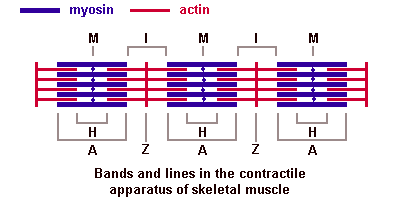
|
- Links: Sarcomere animation | Sarcomere histology
Intercalated Discs
| Cardiac muscle showing intercalated disc (electron micrograph) | |
|---|---|
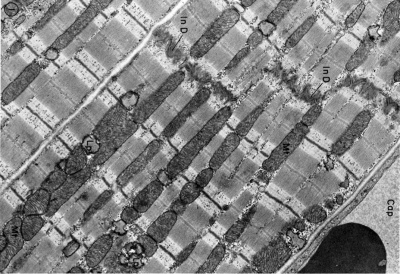
|
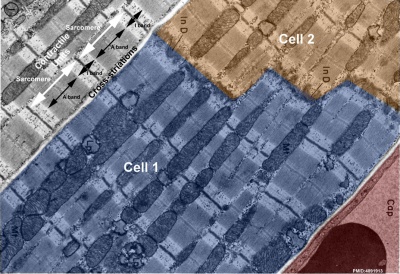
|
|
Histology "step-like" appearance due to:
|
| Junctional Components | ||
|---|---|---|

|
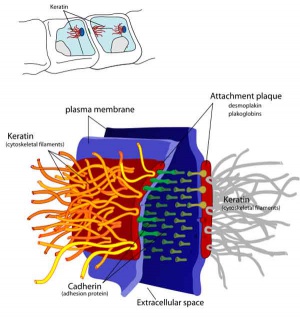
|
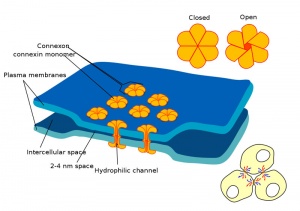
|
| Adherens Junction | Desmosome | Gap junction |
| Fascia adherens – major portion of transverse component. Anchoring sites for actin, and connect to the closest sarcomere. | Macula adherens – (desmosomes) transverse and lateral components. Bind individual myocytes to one another. stop separation during contraction by binding intermediate filaments, joining the cells together. Macula adherens junctions are also called desmosomes. | Gap junctions - lateral component. Allow action potentials to spread between cardiac cells by passage of ions between cells, producing depolarization of the heart muscle. Allows muscle to act as syncytium. |
- Links: EM image - intercalated disc
Purkinje Fibres
Do not confuse these cardiac Purkinje fibres (cells) with neural Purkinje cells (neurons) located in the cerebellum.
- modified cardiac muscle cells. Compared to ordinary cardiac muscle cells:
- contain large amounts of glycogen.
- fewer myofibrils.
- thicker cells.
- can be binucleated (cell contains 2 nuclei).
- extend from the atrioventricular node, pierces the fibrous body, divides into left and right bundles, and travels, beneath the endocardium, towards the apex of the heart.
- bundle branches contact cardiac muscle cells through specialisations similar to intercalated discs.
- conduct stimuli faster than ordinary cardiac muscle cells (2-3 m/s vs. 0.6 m/s).
- discovered in 1839 by Jan Evangelista Purkyně).
Cardiac Valves
Note for the semilunar valves not anchored to the walls of the atria by chordae tendineae.
Only the mitral and tricuspid valves, located between the atria and the ventricles, are connected to the cardiac wall by chord tendineae and papillary muscles.
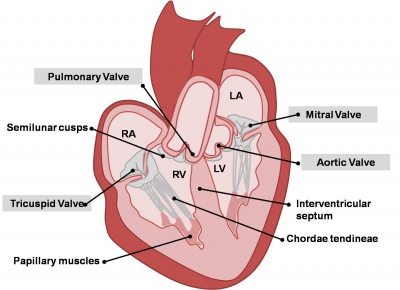
|

|
- Links: Heart Histology | Cardiac AZB Labeled | Cardiac AZB | Cardiac label LS | Cardiac LS | Cardiac label TS | Cardiac TS | Purkinje fibres | Purkinje fibres detail | Histology
Terms
- cardiomyocyte -
- chordae tendineae - tricuspid and mitral valves connective tissue bands attached on the other end to the papillary muscles.
- intercalated disc -
- nodule - (of semilunar valve) small fibrous nodules located in the middle of the flaps, the nodules of the semilunar valve come closely together to fill the triangular opening.
- Purkinje fibres -
References
External Links
External Links Notice - The dynamic nature of the internet may mean that some of these listed links may no longer function. If the link no longer works search the web with the link text or name. Links to any external commercial sites are provided for information purposes only and should never be considered an endorsement. UNSW Embryology is provided as an educational resource with no clinical information or commercial affiliation.
Need to update links
- Blue Histology Cardiac Muscle
- UNSW Virtual Slides Science ANAT2241 Cardiovascular System (requires login for access).
- UIOWA Virtual Slidebox of Histology Heart
Glossary Links
- Glossary: A | B | C | D | E | F | G | H | I | J | K | L | M | N | O | P | Q | R | S | T | U | V | W | X | Y | Z | Numbers | Symbols | Term Link
Cite this page: Hill, M.A. (2024, April 28) Embryology Cardiovascular System - Heart Histology. Retrieved from https://embryology.med.unsw.edu.au/embryology/index.php/Cardiovascular_System_-_Heart_Histology
- © Dr Mark Hill 2024, UNSW Embryology ISBN: 978 0 7334 2609 4 - UNSW CRICOS Provider Code No. 00098G
